

We may earn from vendors via affiliate links or sponsorships. This might affect product placement on our site, but not the content of our reviews. See our Terms of Use for details.
This is a comprehensive list of the best web-based project management software, covering features, pricing, and more. Use this guide to find your best fit.
While some people like the option of downloading a desktop app, plenty of others prefer to use a web-based project management software that doesn’t require you to download anything. Fortunately, there are many different web-based project management software platforms out there to choose from — which makes it difficult to make a final selection.
In this guide, we round up the top 10 web-based project management software that you should consider using this year.
TechRepublic is able to offer our services for free because some vendors may pay us for web traffic or other sales opportunities. Our mission is to help technology buyers make better purchasing decisions, so we provide you with information for all vendors — even those that don’t pay us.


Small (50-249 Employees), Medium (250-999 Employees), Large (1,000-4,999 Employees), Enterprise (5,000+ Employees) Small, Medium, Large, Enterprise
Agile Development, Analytics / Reports, API, and more
Medium (250-999 Employees), Large (1,000-4,999 Employees), Enterprise (5,000+ Employees) Medium, Large, Enterprise
Agile Development, Analytics / Reports, API, and moreWhile cloud-based project management software do offer a lot of the same functionality, each platform also offers its own unique set of features that set it apart from the back. In the chart below, we’ve summarized some of the most essential features to look for in web-based project management software.
| Software | Native time tracking | Built-in chat messaging | Built-in automations | Starting price |
|---|---|---|---|---|
| monday.com | Yes | Yes | Yes | $9 per user/month |
| ClickUp | Yes | Yes | Yes | $7 per user/month |
| Teamwork | Yes | Add-on | Yes | $5.99 per user/month |
| Smartsheet | Yes | No | Yes | $9 per user/month |
| Zoho Projects | Yes | Yes | Yes | $5 per person/month |
| Meistertask | Yes | No | Yes | $11.99 per user/month |
| Hive | Yes | Yes | Yes | $5 per user/month |
| Notion | No | No | No | $8 per user/month |
| Wrike | Yes | No | Yes | $9.80 per user/month |
| Coda | No | No | Yes | $10 per user/month |

monday work management is one of the most well-rounded web-based project management software on the market today. In addition to classic features like multiple project views and time tracking, it also incorporates helpful tools that many other project management platforms lack, such as invoicing creation. It is also highly scalable and flexible, working for teams both large and small across many different industries, which is why it’s one of the most popular agile project management software as well.
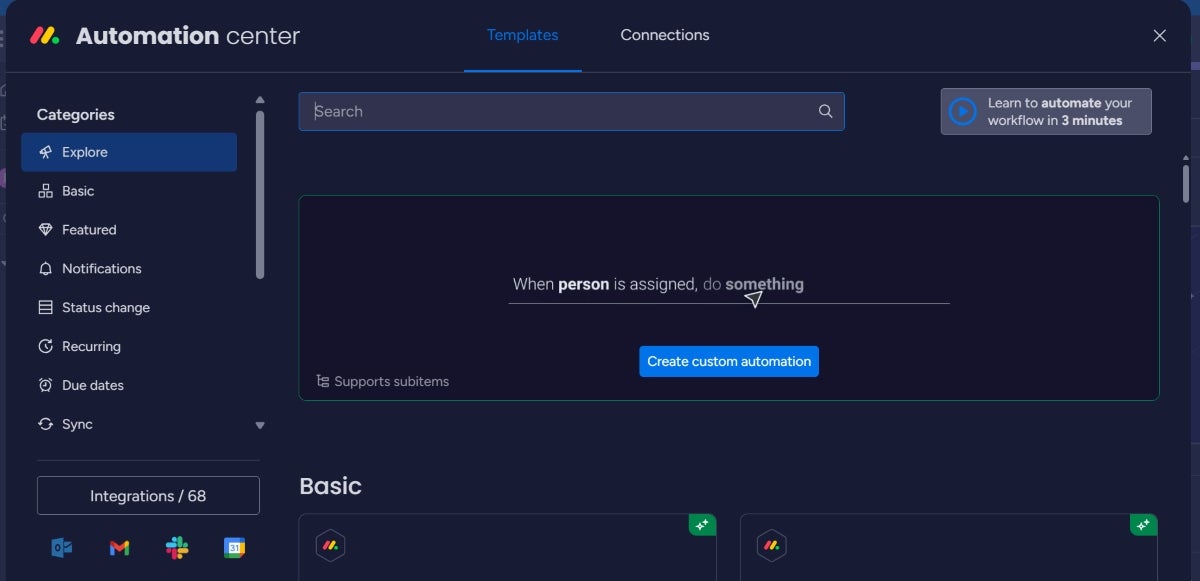
monday.com’s top integrations include Google Calendar, Salesforce, DocuSign, Slack and HubSpot.
We chose monday.com for its project management all-roundness alongside an easily accessible, user-friendly interface and customizable features, which make it a great choice for web-based project management.

Similar to monday work management, ClickUp is a robust project management tool that is designed for managing multiple complex projects at once. It also includes native time tracking, document management and more than 15 project views. However, ClickUp doesn’t have native billing and invoicing tools, so professional service teams should keep that in mind. You can easily integrate with other tools thanks to ClickUp’s 1,000+ Zapier connections.
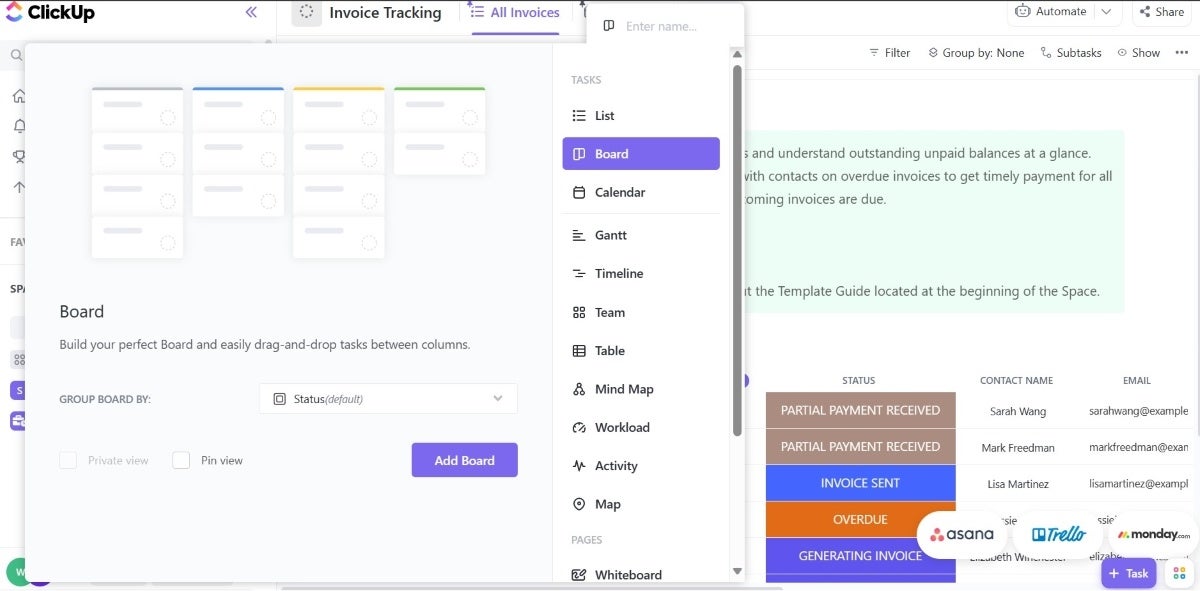
ClickUp integrates seamlessly with Slack, HubSpot, Make, Gmail and Zoom.
ClickUp made our list because of its adaptability and truly diverse feature set, as it combines task management, document sharing and time tracking in a single app while maintaining flexibility and high customizability to cater to users of all kinds and teams of all sizes.
For more information, read the full ClickUp review.
Teamwork is another fully featured web-based project management software that includes many features helpful for client-facing teams, including document proofing, time tracking and invoice creation tools. You can also create reports and easily share them internally or externally in multiple formats. Even better, Teamwork’s pricing plans are on the more affordable end, making it a great combination of cost and functionality.
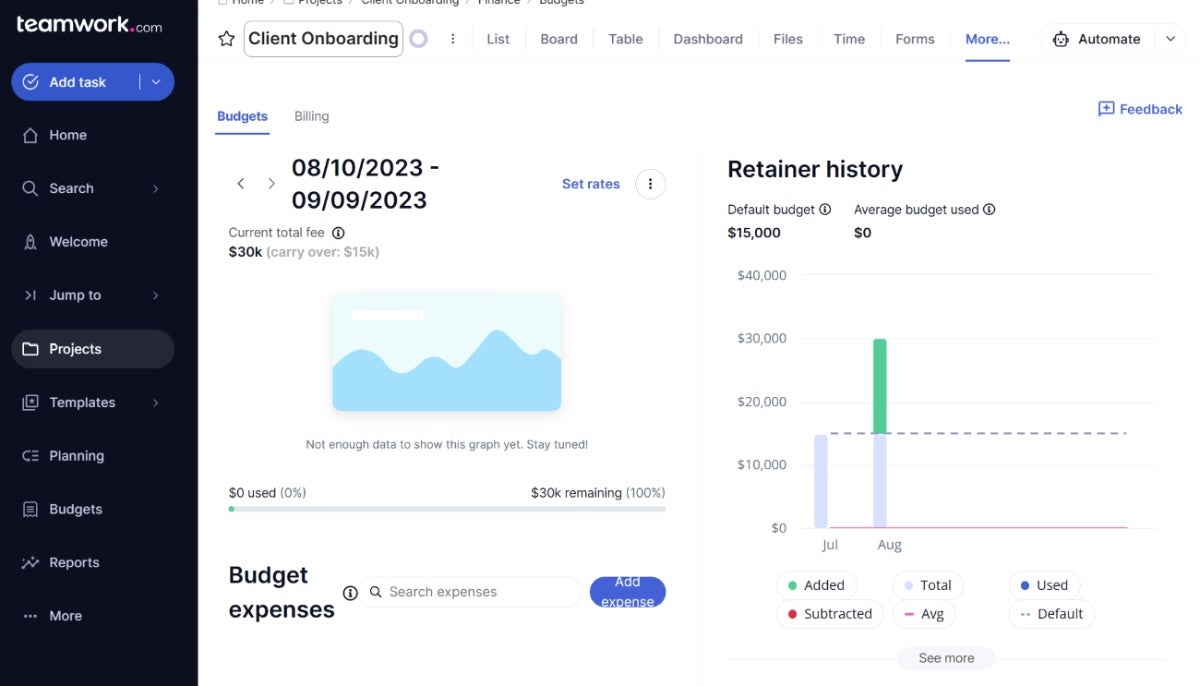
Teamwork’s top integrations include Google Drive, Microsoft Office, Slack, QuickBooks and HubSpot.
We chose Teamwork for its strong focus on collaboration and ease of use, particularly in use cases that involve client-facing interactions. With features such as time and budget tracking, Teamwork makes it easy to handle both internal team projects as well as those that involve external stakeholders like clients.
For more information, read the full Teamwork review.
![]()
If you’ve ever wished that you could manage projects in an online spreadsheet (or are currently doing that now), then Smartsheet was designed with you in mind. Smartsheet combines a cloud-based, grid-like interface with robust project management features and affordable prices to create an extremely useful software platform. You can also try out other project views, like Gantt charts and calendars, if the grid view isn’t working for you.
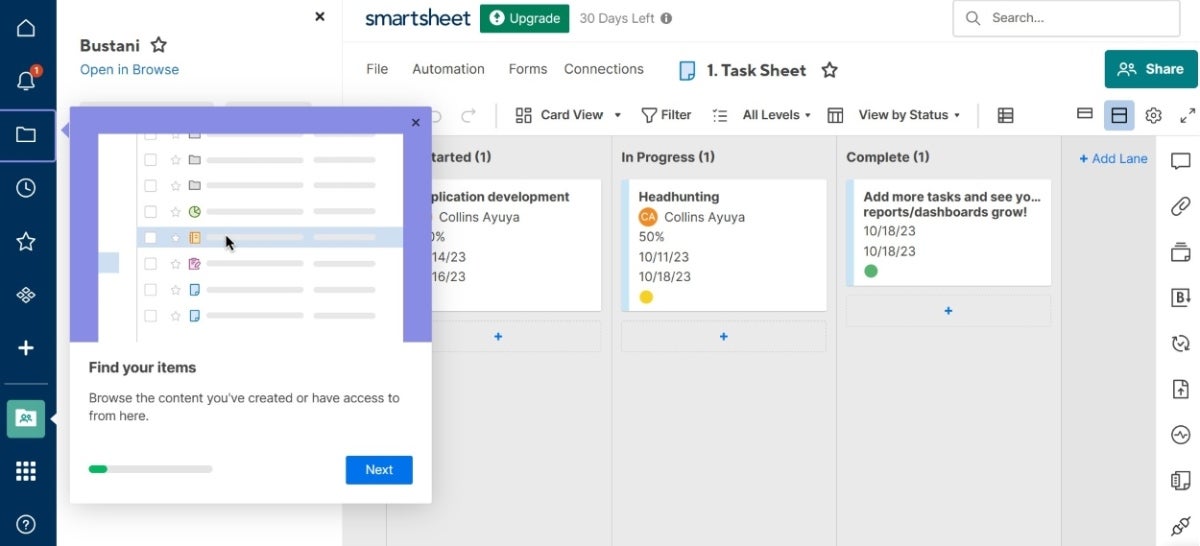
Smartsheet’s key integrations include Microsoft Teams, Slack, Google Workspace, Salesforce and Jira.
Smartsheet sets itself apart through its spreadsheet-like interface. Anyone who’s worked with spreadsheets to track projects will love Smartsheet, as it makes it so much easier and is capable of handling quite complex projects.
While Zoho Projects was designed to be used in conjunction with the rest of the Zoho software stack, it also makes a compelling case for itself thanks to its great selection of features and its affordable price tag: Paid plans start at just $5 per person per month.
The software is also relatively easy to master, even if you’ve never used a Zoho product before, making it a great choice for teams looking for their first web-based project management software.
![]()
Zoho Projects’ top integrations include Zoho CRM and Zoho Analytics as well as other Zoho products, Slack, GitHub and Google Workspace.
We selected Zoho Projects for its seamless integration with the Zoho ecosystem. Any user that’s already using multiple Zoho products should have Zoho Projects at the top of their project management shortlist. It’s also affordable, flexible and can handle complex projects.
You probably know Meister for its digital collaboration tool MindMeister, but it also makes a project management platform called MeisterTask. This easy-to-use software sports a friendly, colorful interface that won’t intimidate beginners and it offers a relatively low learning curve. It’s a great option for simple task management, but isn’t powerful enough to handle extremely complex projects and lacks some features like pre-built templates.
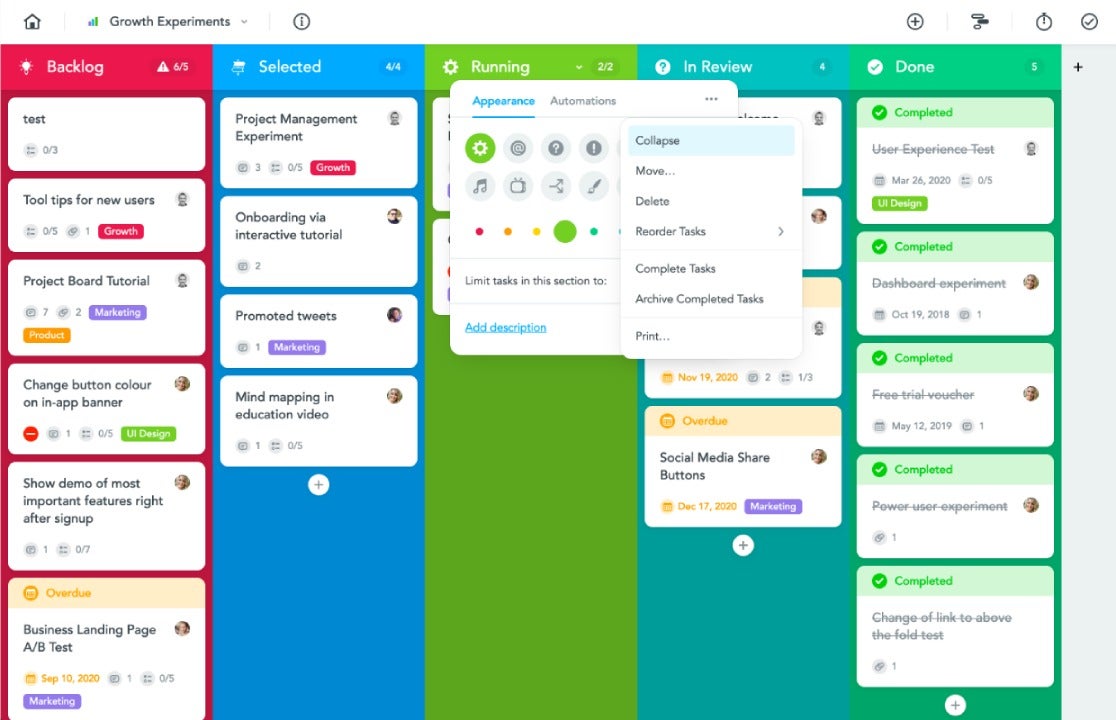
MeisterTask’s top integrations are Slack, GitHub, MindMeister, Office 365 and Zendesk.
MeisterTask has a visually appealing and intuitive interface that makes task management both efficient and enjoyable. Plus, its integration with MindMeister for mind mapping gives a unique approach to project planning and brainstorming.
Hive has a unique goal setting feature that lets you set and track goals and subgoals for your entire team. This keeps your entire team focused on the big picture and encourages your entire company to work together to meet your business goals. Goals can be task-based, numerical, monetary or custom, depending on your needs.
It also includes project management features such as Kanban boards and Gantt charts, time tracking and team collaboration tools.
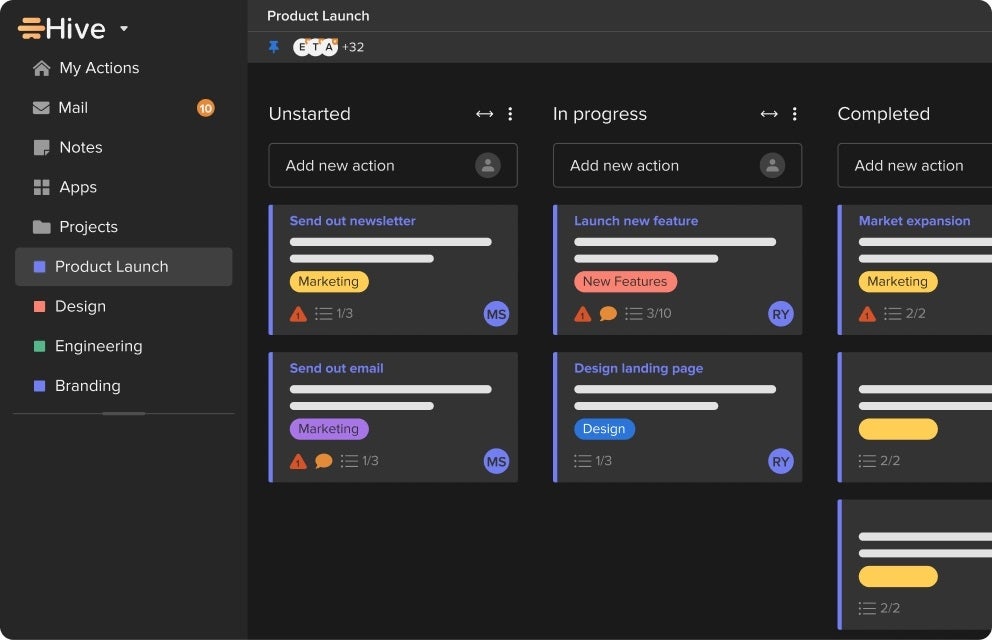
Hive’s top integrations include Slack, Google Drive, Zoom, Dropbox and Microsoft Teams.
We chose Hive for its adaptability. There are various workflow styles, including Kanban, Gantt and calendar views. Its emphasis on AI-based analytics gives users actionable data to improve their productivity and decision-making.
For more information, read the full Hive review.
Notion is a multi-purpose productivity app that combines note taking, document organization, task management and project management. While its features aren’t suitable for very complex projects — it lacks Gantt charts, for example — it’s a great choice for creative teams that have a lot of files and documents they need to manage.
Basically, Notion combines knowledge management, task management and project management into one easy-to-use tool.
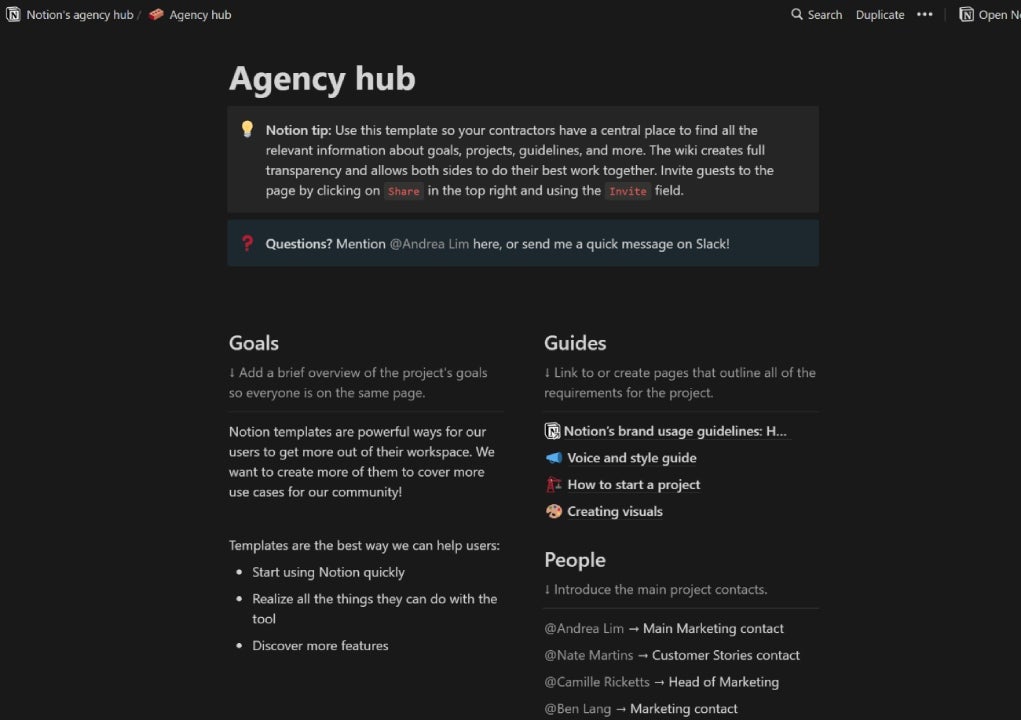
Notion’s top integrations include Google Drive, Trello, Slack, Figma and GitHub.
Notion uniquely consolidates notes, databases and project management into a single, highly customizable platform. It adapts to multiple workflows and offers lots of integrations, which makes it a versatile all-in-one productivity tool.
For more information, read the full Notion review.

Wrike is designed with power users in mind, which makes it an excellent choice for project portfolio management. The learning curve will likely be intimidating to users who aren’t familiar with web-based project management software, but it’s hard to beat the sheer number of features and customizability that Wrike offers for more advanced users. If your current solution just isn’t powerful for your needs, then Wrike is definitely worth a look.
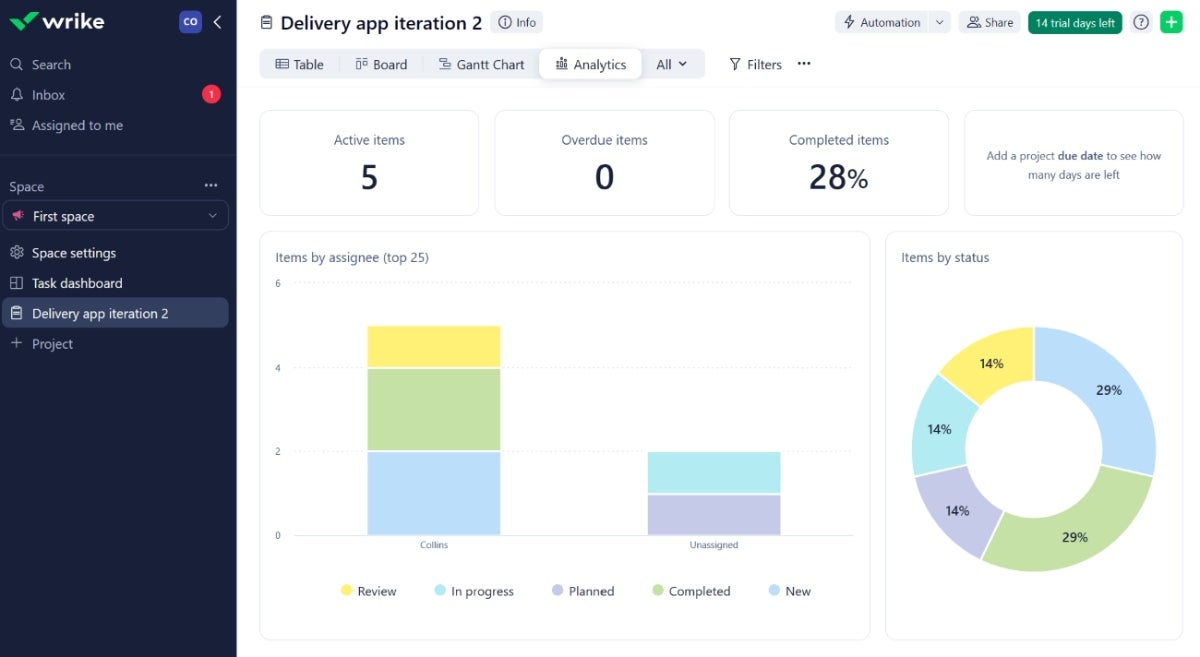
Wrike’s top integrations are Salesforce, Tableau, Slack, Microsoft Teams and Adobe Creative Cloud.
We shortlisted Wrike for its highly detailed approach to project planning and tracking capabilities, including interactive Gantt charts and customizable dashboards. Wrike also has a focus on scalability and security, and is suitable for large and complex projects.
For more information, read the full Wrike review.
Coda is a bit different from the other platforms on this list, and it focuses on note taking and document management. It also offers some project management features, including Gantt charts and Kanban boards, so it will suffice for simple task and product management needs. But where it really shines is its documentation features, making it the perfect choice for teams that need to create and manage databases, spreadsheets and documents.
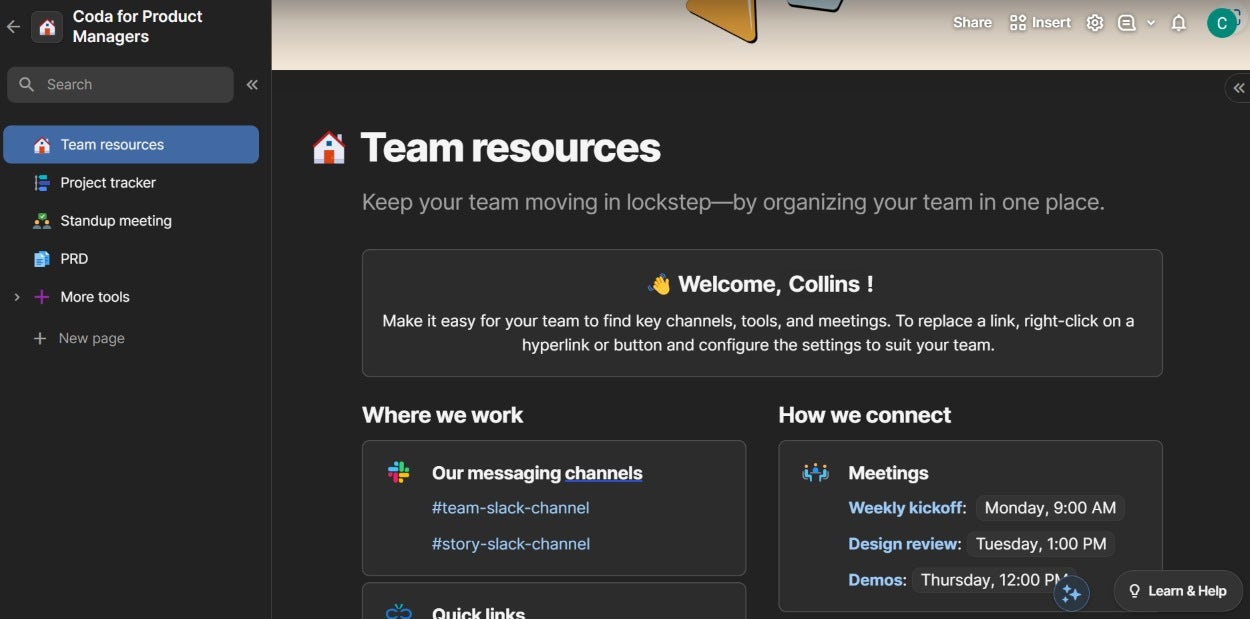
Coda integrates with a variety of tools, including Slack, Google Calendar, Gmail, Jira and Shopify.
Coda impressed us with its unique blend of document creation and project management capabilities, offering teams the flexibility to create custom workflows and collaborate in a dynamic, all-in-one workspace. It also has powerful customization options and an extensive template library for teams to approach projects as quickly and flexibly as possible.
For more information, read the full Coda review.
You should be able to create tasks, set deadlines and assign them to yourself and others. Additionally, you should have the option to view all your upcoming tasks in a dashboard or another centralized place, and set up alerts and notifications when certain actions take place. Ideally, you should also be able to create subtasks and task dependencies to keep everything organized.
The best web-based project management software should provide multiple project views to choose from. The most common are calendars, Kanban boards (sometimes called card view), spreadsheets (sometimes called grid view) and timeline view (typically known as Gantt charts). Many software platforms restrict Gantt charts to a paid plan to encourage people to sign up for a subscription.
Most project software provides a vast library of hundreds of project templates to choose from. These templates are usually designed for a wide range of teams and industries, from marketing to software development to accounting and beyond. The best web-based project management software will also give you the ability to create and save your own custom templates.
Time tracking is absolutely essential for teams that are paid hourly or need to track billable hours for clients. It can also be useful for salaried workers to see where their time is going. Many (though not all) web-based project management software platforms offer time tracking, but some restrict it to a higher tiered paid plan or require you to pay for an add-on.
Automations eliminate redundant manual work and help reduce the chances of errors. While this feature was once less common, right now most web-based project management software allows you to create and save custom automated workflows. However, some cap the number of automation actions based on which pricing tier you pay for, so it’s worth asking the sales team about this on the call.
No two web-based project management software offer exactly the same features. At the very start of your search, you and your team should identify your must-have and nice-to-have features, and use that to narrow down your options. For instance, if you specifically want open source project management software, that will significantly limit your options.
Most web-based project management software offer both a free trial and a forever free plan with restricted features. Use both of these options liberally to test the software out on your own to make sure that it can do what you actually want it to do. Demo calls with the sales team can also be helpful if you come prepared with questions ahead of time.
If you’re not totally sold on a certain web-based project management software, then choosing a month-to-month plan will let you test it out without committing to an annual contract. If you decide that you’ve found the perfect web-based project management software for your needs, then you can switch to an annual pricing plan to save some money.
We reviewed this web-based project management software based on a number of criteria, including pricing, ease of use, user interface design and the difficulty of the learning curve. We also weighed additional features such as document management, automation, project views, templates, time tracking and billing and invoicing. We evaluated these platforms by consulting user reviews and product documentation.
Subscribe to Project Management Insider for best practices, reviews and resources. From project scheduling software to project planning apps, stay up to date with the latest in project management tools. Delivered Wednesdays
Subscribe to Project Management Insider for best practices, reviews and resources. From project scheduling software to project planning apps, stay up to date with the latest in project management tools. Delivered Wednesdays
Share Article
Collins Ayuya is pursuing his Master's in Computer Science and is passionate about technology. He loves sharing his experience in Artificial Intelligence, Telecommunications, IT, and emerging technologies through his writing. He is passionate about startups, innovation, new technology, and developing new products as he is also a startup founder. Collins enjoys doing pencil and graphite art and is also a sportsman and gamer during his downtime.